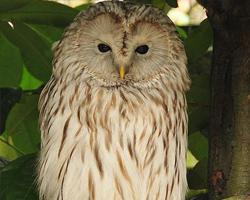
Váhy a míry
| Délka | 21 cm |
|---|
Stav ohrožení
| Ohrožen |
Popis zvířete
The Spotted Owlet (Athene brama), a small yet captivating bird, is a species that belongs to the owl family, Strigidae. It is predominantly found across the Indian subcontinent and some adjoining regions, flourishing in a variety of habitats including open farmland, scrubland, and lightly wooded areas, as well as being a common sight in urban settings near human habitation.Characteristically, the Spotted Owlet stands out with its compact size, measuring about 19 to 21 cm in length. It possesses a round head without ear tufts, a feature that distinguishes it from many other owl species. The bird's plumage is predominantly a mottled mix of brown, white, and buff colors, providing it with excellent camouflage against the bark of trees. The most striking features are its bold white spots and streaks that adorn its head, back, and wings. Its underparts are a lighter, more uniform color, often a soft, pale brown or gray, speckled with darker spots. The facial disc is not as prominent as in other owl species, but its large, yellow eyes are distinctive, framed by a dark rim, giving it a piercing gaze. The Spotted Owlet's beak is short, curved, and yellowish-green, adept at catching a variety of prey.
One of the most enchanting aspects of the Spotted Owlet is its behavior. It is primarily nocturnal but is also often active at dawn and dusk. Unlike many other owl species, it can frequently be observed during daylight hours, especially in the early morning or late afternoon, sunbathing or preening in groups. These owlets are highly social and communicative, known for their loud and varied calls that include a series of harsh screeches and softer chuckles. They are territorial and live in small family groups, often seen roosting together in tree hollows, abandoned buildings, or crevices in cliffs.
The diet of the Spotted Owlet is diverse, consisting mainly of insects such as beetles, crickets, and moths, but it also preys on small mammals, birds, and reptiles. Its hunting technique is as fascinating as its diet is varied; the owlet will perch silently on a vantage point before swooping down on its prey with remarkable precision.
Breeding season for the Spotted Owlet varies geographically but generally occurs before the onset of the monsoon. The nests are usually located in natural cavities in trees, old buildings, or even in the ground. The female typically lays 3 to 5 eggs, which are incubated for about 30 days. Both parents are involved in rearing the young, which fledge approximately a month after hatching.
The Spotted Owlet plays a crucial role in its ecosystem as a predator of pest species, thus aiding in the natural control of insect and rodent populations. Despite facing threats from habitat destruction and pesticide use, the species is currently listed as Least Concern by the International Union for Conservation of Nature (IUCN), thanks to its wide distribution and adaptability to human-modified landscapes.
In summary, the Spotted Owlet is a small, yet fascinating bird with distinctive markings and sociable behavior. Its adaptability to diverse environments and its role in natural pest control underscore the importance of conserving its habitat and ensuring the species continues to thrive across the Indian subcontinent.
Mapa výskytu

Podobná zvířata
Nové fotografie zvířat
Top 10 zvířat
- Dolphin gull (Leucophaeus scoresbii)
- Diana monkey (Cercopithecus diana)
- Moustached guenon (Cercopithecus cephus)
- Galápagos tortoise (Geochelone nigra complex)
- Stone loach (Barbatula barbatula)
- Japanese macaque (Macaca fuscata)
- Russian tortoise (Testudo horsfieldii)
- Greek tortoise (Testudo graeca)
- Common flying dragon (Draco volans)
- Vendace (Coregonus albula)


